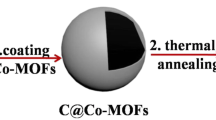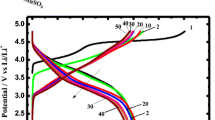Abstract
The development of hierarchical micro-/nanostructures has received great attention in the field of electrochemical energy storage and conversion. In this report, we demonstrate a template-free synthesis of LiV3O8 hollow microspheres from vanadium ethylene glycolate intermediate, which in turn was obtained by a facile solvothermal route. Evaluation of morphological features with FE-SEM and HR-TEM shows hollow spheres of size 1.8 ± 0.1 µm diameters with wall thickness and void size of 200 ± 20 nm and 1.5 ± 0.1 µm, respectively. Powder X-ray diffraction confirms that both the intermediate and LiV3O8 hollow spheres are highly crystalline without any impurity phase. Tested as a positive electrode in lithium-ion batteries, the LiV3O8 hollow spheres constructed electrode shows a discharge capacity of 304 mAh g−1 at 0.1 C rate and 246 mAh g−1 at 1 C rate during the first discharge. More importantly, LiV3O8 electrode delivers stable cycle-life performance with a specific capacity of 156 mAh g−1 after 300 (dis)charges at 1 C rate. The present hollow LiV3O8 structures would be expected to offer additional active sites, void space to counter volume expansion, and thin-shell structures to provide shortest path for Li+ ion/electron transport, thereby enhancing the cycling stability and rate performance.











Similar content being viewed by others
References
Braithwaite JS, Catlow CRA, Gale JD, Harding JH (1999) Lithium intercalation into vanadium pentoxide: a theoretical study. Chem Mater 11:1990–1998. https://doi.org/10.1021/cm980735r
Chae OB, Kim J, Park I, Jeong H, Ku JH, Ryu JH, Kang K, Oh SM (2014) Reversible lithium storage at highly populated vacant sites in an amorphous vanadium pentoxide electrode. Chem Mater 26:5874–5881. https://doi.org/10.1021/cm502268u
Liu M, Su B, Tang Y, Jiang X, Yu A (2017) Recent advances in nanostructured vanadium oxides and composites for energy conversion. Adv Energy Mater 7:1700885. https://doi.org/10.1002/aenm.201700885
Qiao YQ, Tu JP, Wang XL, Zhang J, Yu YX, Gu CD (2011) Self-assembled synthesis of hierarchical waferlike porous Li–V–O composites as cathode materials for lithium ion batteries. J Phys Chem C 115:25508–25518. https://doi.org/10.1021/jp2080176
West K, Zachau-Christiansen B, Skaarup S, Said Y, Barker J, Olsen II, Pynenburg R, Koksbang R (1996) Comparison of LiV3O8 cathode materials prepared by different methods. J Electrochem Soc 143:820. https://doi.org/10.1149/1.1836543
Sarkar S, Banda H, Mitra S (2013) High capacity lithium-ion battery cathode using LiV3O8 nanorods. Electrochim Acta 99:242–252. https://doi.org/10.1016/j.electacta.2013.03.083
Wadsley AD (1957) Crystal chemistry of non-stoichiometric pentavalent vanadium oxides: crystal structure of Li1+xV3O8. Acta Crystallogr 10:261–267. https://doi.org/10.1107/S0365110X57000821
Pan A, Liu J, Zhang J-G, Cao G, Xu W, Nie Z, Jie X, Choi D, Arey BW, Wang C, Liang S (2011) Template free synthesis of LiV 3 O 8 nanorods as a cathode material for high-rate secondary lithium batteries. J Mater Chem 21:1153–1161. https://doi.org/10.1039/C0JM02810J
Xu HY, Wang H, Song ZQ, Wang YW, Yan H, Yoshimura M (2004) Novel chemical method for synthesis of LiV3O8 nanorods as cathode materials for lithium ion batteries. Electrochim Acta 49:349–353. https://doi.org/10.1016/j.electacta.2003.08.017
Chen Z, Xu F, Cao S, Li Z, Yang H, Ai X, Cao Y (2017) High rate, long lifespan LiV3 O8 nanorods as a cathode material for lithium-ion batteries. Small 13:1603148. https://doi.org/10.1002/smll.201603148
Liu H, Wang Y, Wang K, Wang K, Zhou H (2009) Synthesis and electrochemical properties of single-crystalline LiV3O8 nanorods as cathode materials for rechargeable lithium batteries. J Power Sources 192:668–673. https://doi.org/10.1016/j.jpowsour.2009.03.066
Huang S, Wang XL, Lu Y, Jian XM, Zhao XY, Tang H, Cai JB, Gu CD, Tu JP (2014) Facile synthesis of cookies-shaped LiV3O8 cathode materials with good cycling performance for lithium-ion batteries. J Alloys Compd 584:41–46. https://doi.org/10.1016/j.jallcom.2013.09.034
Wang H, Ren Y, Wang Y, Wang W, Liu S (2012) Synthesis of LiV3O8 nanosheets as a high-rate cathode material for rechargeable lithium batteries. CrystEngComm 14:2831. https://doi.org/10.1039/c2ce06326c
Heli H, Yadegari H, Jabbari A (2011) Investigation of the Lithium Intercalation Behavior of Nanosheets of LiV3 O8 in an Aqueous Solution. J Phys Chem C 115:10889–10897. https://doi.org/10.1021/jp201382n
Tan H, Rui X, Sun W, Yan Q, Lim TM (2015) Vanadium-based nanostructure materials for secondary lithium battery applications. Nanoscale 7:14595–14607. https://doi.org/10.1039/c5nr04126k
Ren W, Zheng Z, Luo Y, Chen W, Niu C, Zhao K, Yan M, Zhang L, Meng J, Mai L (2015) An electrospun hierarchical LiV 3 O 8 nanowire-in-network for high-rate and long-life lithium batteries. J Mater Chem A 3:19850–19856. https://doi.org/10.1039/c5ta04643b
Nair VS, Cheah YL, Madhavi S (2014) Symmetric aqueous rechargeable lithium battery using Na 1.16 V 3 O 8 nanobelts electrodes for safe high volume energy storage applications. J Electrochem Soc 161:A256–A263. https://doi.org/10.1149/2.025403jes
Mo R, Du Y, Zhang N, Rooney D, Sun K (2013) In situ synthesis of LiV3O8 nanorods on graphene as high rate-performance cathode materials for rechargeable lithium batteries. Chem Commun 49:9143–9145. https://doi.org/10.1039/c3cc43975e
Lou XW, Archer LA, Yang Z (2008) Hollow micro-/nanostructures: synthesis and applications. Adv Mater 20:3987–4019. https://doi.org/10.1002/adma.200800854
Sasidharan M, Nakashima K (2014) Core–shell–corona polymeric micelles as a versatile template for synthesis of inorganic hollow nanospheres. Acc Chem Res 47:157–167. https://doi.org/10.1021/ar4001026
Cao A-M, Hu J-S, Liang H-P, Wan L-J (2005) Self-assembled vanadium pentoxide (V2O5) hollow microspheres from nanorods and their application in lithium-ion batteries. Angew Chemie Int Ed 44:4391–4395. https://doi.org/10.1002/anie.200500946
Bin WuH, Chen JS, Hng HH, Lou XW (2012) Nanostructured metal oxide-based materials as advanced anodes for lithium-ion batteries. Nanoscale 4:2526–2542. https://doi.org/10.1039/c2nr11966h
Pan A, Zhu T, Bin WuH, Lou XW (2013) Template-free synthesis of hierarchical vanadium-glycolate hollow microspheres and their conversion to V2O5 with improved lithium storage capability. Chem A Eur J 19:494–500. https://doi.org/10.1002/chem.201203596
Pan A, Bin WuH, Yu L, Lou XWD (2013) Template-free synthesis of VO2 hollow microspheres with various interiors and their conversion into V2O5 for lithium-ion batteries. Angew Chem Int Ed 52:2226–2230. https://doi.org/10.1002/anie.201209535
Sasidharan M, Gunawardhana N, Yoshio M, Nakashima K (2012) V2O5 hollow nanospheres: a lithium intercalation host with good rate capability and capacity retention. J Electrochem Soc 159:A618–A621. https://doi.org/10.1149/2.082205jes
Liu J, Zhou Y, Wang J, Pan Y, Xue D (2011) Template-free solvothermal synthesis of yolk-shell V 2O 5 microspheres as cathode materials for Li-ion batteries. Chem Commun 47:10380–10382. https://doi.org/10.1039/c1cc13779d
Liu J, Liu W, Wan Y, Ji S, Wang J, Zhou Y (2012) Facile synthesis of layered LiV3O8 hollow nanospheres as superior cathode materials for high-rate Li-ion batteries. RSC Adv 2:10470. https://doi.org/10.1039/c2ra20969a
Thamodaran P, Kesavan T, Vivekanantha M, Senthilkumar B, Barpanda P, Sasidharan M (2019) Operando structural and electrochemical investigation of Li1.5V3O8 nanorods in li-ion batteries. ACS Appl Energy Mater 2:852–859. https://doi.org/10.1021/acsaem.8b01915
Bonino F, Panero S, Pasquali M, Pistoia G (1995) Rechargeable lithium batteries based on Li1 + xV3O8 thin films. J Power Sources 56:193–196. https://doi.org/10.1016/0378-7753(95)80033-D
Tanguy F, Gaubicher J, Guyomard D (2010) Capacity fading on cycling nano size grains of Li1.1V3O8, electrochemical investigation. Electrochim Acta 55:3979–3986. https://doi.org/10.1016/j.electacta.2009.12.038
Acknowledgements
The authors acknowledge the Ministry of New and Renewable Energy (MNRE), Govt. of India, for financial assistance (No. 31/03/2014-15/PVSE-R&D). The authors thank SRM SCIF and Nanotechnology Research Centre, SRMIST, for providing facility for FE-SEM and HR-TEM analysis. T. P. thanks Council of Scientific and Industrial Research (CSIR) for providing senior research fellowship (SRF).
Author information
Authors and Affiliations
Corresponding author
Ethics declarations
Conflict of interest
The authors declare there is no conflict of interest.
Additional information
Publisher's Note
Springer Nature remains neutral with regard to jurisdictional claims in published maps and institutional affiliations.
Electronic supplementary material
Below is the link to the electronic supplementary material.
Rights and permissions
About this article
Cite this article
Partheeban, T., Sasidharan, M. Template-free synthesis of LiV3O8 hollow microspheres as positive electrode for Li-ion batteries. J Mater Sci 55, 2155–2165 (2020). https://doi.org/10.1007/s10853-019-04086-3
Received:
Accepted:
Published:
Issue Date:
DOI: https://doi.org/10.1007/s10853-019-04086-3




